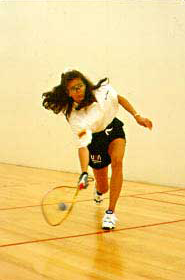|
|

Stringing For Tournament Play
By Steve Crandall
Vice President, Sales & Marketing
Ashaway Racket Strings
 With the first U.S. Open Racquetball Championships coming up soon in Memphis, let’s consider racquet stringing for tournament play. The stakes are higher in tournaments than in general recreational play, as are the demands placed on the equipment. With the first U.S. Open Racquetball Championships coming up soon in Memphis, let’s consider racquet stringing for tournament play. The stakes are higher in tournaments than in general recreational play, as are the demands placed on the equipment.
By the time you make it to a tournament, you should have resolved, at least temporarily, any questions about your equipment. Serious competition is no time to experiment with different racquets, string, shoes, or anything else. After the tournament, you will analyze every decision and every move you made, and that might involve reevaluating your equipment choices. But during the tournament, you must devote full attention to your game. That means having confidence in your equipment, so that you can think about it as little as possible. The key to this confidence is consistency, which is achieved through preparation.
The first step is to supply yourself with numerous racquets, all of which are familiar to you through long usage. When you break a string in the middle of a match, or when the string begins to lose its tension, you want to be able to switch to another racquet and continue playing as if nothing had happened. This is no time to get the feel for a new setup. I’d recommend a minimum of three racquets, although five or six is certainly not out of the question.
Ideally, the racquets should be identical, and they should be strung identically. In practice, however, few players can afford to replace all their racquets simultaneously, and most people have a collection consisting of their newest, favorite racquet, followed by the second-newest, second-favorite, etc. This situation is undesirable but usually unavoidable, and the only good response is to make sure you’ve figured out your favorite stringing setup for each racquet before you go to a tournament.
Even professional stringers have different levels of skill and different stringing methods. Stringing machines also differ: some designs are more precise than others; some may have been more
recently calibrated; and some may have been recently knocked around by baggage handlers.
All of these factors represent possible sources of variation that you want to eliminate or at least minimize. The first, obvious step is to show up at the tournament with all of your racquets pre-strung to your specifications, by your favorite stringer, on his usual machine. But what if you must have a racquet re-strung at the tournament?
If your name is Andre Agassi and your game is tennis, you travel with your personal stringer on your private jet, and he takes very good care of your racquets. That not being the case, you should pack several extra sets of string in your gear bag. It must be the same string you normally use, and you must be able to tell the tournament stringer what tension you want each of your racquets strung at. If you don’t know, ask your stringer back home before you leave. Also ask him about any unusual stringing patterns he uses, and try to get the tournament stringer to follow suit.
Players who are lucky enough to have an equipment sponsor may have an advantage at tournaments, because the sponsor may have a stringer on site to serve his players. A sponsor’s stringer understands his players’ stringing preferences, and can provide consistency from one racquet to the next. (Ashaway will be stringing for its players at the U.S. Open. Please come by and see us.)
Tournament matches seem to take longer, on average, than recreational matches. That’s partly because players tend to be more evenly matched, and partly because every point is taken seriously, so rallies last longer. Racquet string takes more of a beating at tournaments, and may lose five to ten percent of its tension during a single match.
Some players therefore choose to increase their normal stringing tension by 2 or 3 lbs. for tournaments. This, of course, will initially improve the racquet’s control, but it will also decrease its power, and increase the risk of string breakage. Other players do the opposite, and knock a few pounds off their normal tension, on the grounds that it increases their power and reduces breakage.
The decision is a matter of taste, but in no case should the change be a major one. At a tournament, you’re typically playing unknown opponents in unfamiliar surroundings, sleeping in a strange bed, and maybe even trying to adjust to a different time zone. Do yourself a favor and make sure that your equipment, at least, stays the same.
This article previously appeared in Racquetball Magazine.
|